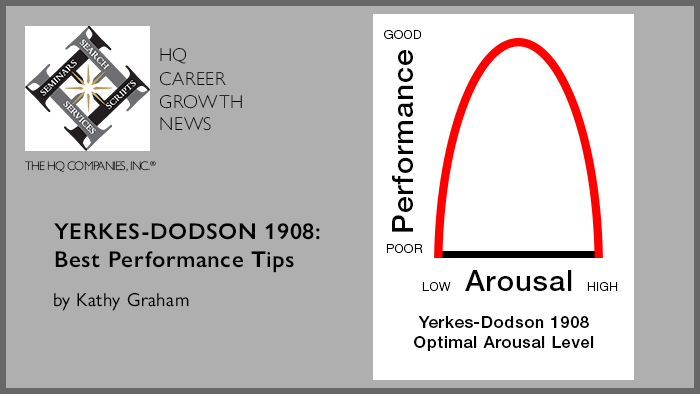The 111-year old Yerkes-Dodson Law is NOT a law, it’s not even statistically significant, and yet it’s really quite useful for making what you want to happen actually occur.
The Yerkes-Dodson Law is a variation on Goldilocks and The Three Bears:- If you have “too little” arousal/stress/engagement, you will under-perform.
- If you have “too much” arousal/stress/engagement, you will under-perform.
- If you have the “just right” level of arousal/stress/engagement, you will reach your best/optimal performance in whatever you are trying to achieve.
The problem with the Yerkes-Dodson Law is that “just right” varies from situation to situation, stimuli to stimuli, and individual to individual...so how do you figure out what the “just right” is for yourself in whatever you’re trying to achieve?
Ask yourself, “How am I feeling? How am I doing/performing right now in what I am trying to achieve?”
If you’re feeling sluggish, not “with it,” and/or saying disengaging statements like, “I don’t care about this X,” AND you’re under-performing, try spicing yourself up with some more colorful emotion. Get psyched. See/hear something motivational—a success story or a movie like Chariots of Fire. Use more colorful emotional words (hmm...is this why marketers and politicians use such words—they want to incite you to perform a certain or more action?).
However, if you’re feeling too angry, too upset, or too overcharged in any way AND you’re under-performing, try the reverse: do something that slows your emotions/reactions down: meditate, take deep breaths or a day off, etc. Substitute for words like “awful,” “horrible,” or “terrible,” the words “sad,” “unfortunate for me,” “not the best,” or “personally unfavorable” until you’re back to feeling motivated to achieve.
Note that being disengaged (the "I don't care about this X" stage) or being angry might be the “just right” reaction level to gain your best/optimal performance in certain situations.
Finding the “just right” level of arousal/stress/engagement is fluid, which is why learning to master when to turn your arousal/stress/engagement level up or down is key to staying in your best/optimal performance zone.
__________________
SOURCES
• History of statistics, Wikipedia
• Merriam Webster, definition of theory, hypothesis, and law and their differences
• “Cognitive, Endocrine and Mechanistic Perspectives on Non-Linear Relationships Between Arousal and Brain Function,” David M. Diamond
• “Nonlinearity in Biology, Toxicology, and Medicine, University of Massachusetts, 2005
• “Yerkes-Dodson: A Law for All Seasons,” Karl Halvor Teigen, 1994
• “Caffeine and Cognitive Performance: The Nonlinear Yerkes-Dodson Law,” Paul Andrew Watters, Frances Martin, Zoltan Schreter, 1999
• “Correct Levels of Stress Hormones Boost Learning, Squirrel Study Suggests,” Jill Mateo, University of Chicago Researcher, 2008
• “The Yerkes-Dodson Law of Arousal,” The ‘Lone Wolf’ Graphic Arts Technologist, 2011
• “Yerkes-Dodson Law,” Praveen Shrestha, Psychestudy, 2017
• “The Yerkes-whatzy law of who now?,” secretGeek.net, 2007
• “16 examples of Yerkes-Dodson Law” described,” online
• “The Yerkes-Dodson Law and Performance,” Kendra Cherry, 2019

